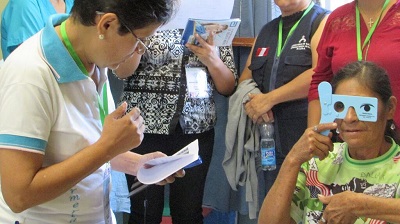Join a powerful, unprecedented alliance for better eye health for all.
Join IAPB-
Choose an alternate language here
“It seems that men can see very well” is an expression we have heard from a resident of Juan Guerra when we accompanied CBM’s partner IPROS to an outreach campaign carried out in San Martin Province. He was refereeing to the fact that it was mostly women who attended the campaign.
The 2011 Rapid Assessment of Avoidable Blindness (RAAB) carried out in Peru for adults over 50 reported prevalence of blindness to be 2% of population. The survey also showed that cataracts are the main cause of blindness with a percentage of 58%. Of these, it would be expected that 41% are men and 59% are women. Hence, any eye health programme with equitable access to services would expect a higher percentage of women users. CBM’s Seeing is Believing programme in Peru is ensuring this equal access to services is reflected in the programme.
At the community level, it has been relatively easy to achieve this as people who attend campaigns and community eye health awareness talks are mostly women. The programme has investigated this and has found a few factors explaining this situation.
One of the key one is the distinct tasks assigned to each family members. This is the case particularly in rural areas where men work in agriculture, cattle raising or construction labor even when they are elderly. Women stay at home, cooking and taking care of children, or carry out some informal and independent economic activities which contribute to the family income although the income is generally low.
The same gender specific tasks also apply to older women. This segregation of tasks seems to leave women with more time to attend to their health and they also seem to give a higher priority to seeking medical treatment.
On the other hand, men usually do not prioritize their visual problems unless the severity of blindness does not allow them to perform their daily tasks. That partly comes from the machismo culture heritage where a man should consistently come across as strong and healthy hence health seeking behaviors reflect that pressure.

The proportion of women who received surgery in the programme is 55% of total surgeries which is quite close to the RAAB study which estimated that 59% of persons with cataract would be women.
The gap is explained partly by the fact that some women’s capacity of deciding to undergo surgery is still defendant on their husband or the “head of the family” as they would control the family’s income.
This can be partly addressed by involving the eldest son in the process, having him accompany the mother when she goes to the clinics.
Another strategy used by CBM’s partner CECOM is to visit patients with cataracts at their home which allows counseling not only the patient but all family members.
Another approach has been to include patients who have undergone surgery into to screening campaign to talk about their experience and to coordinate screening with payment schedule of subsidies to elderly persons.
Finally, the fact that 71% of the SiB Programme partner clinics staff are women is having a positive impact on the uptake of women in the programme.

SiB project manager
CBM Peru
[email protected]